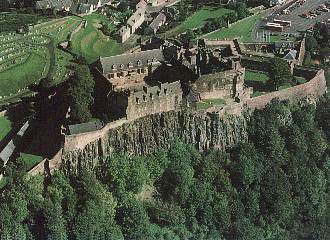 |
 |

Stirling Castle
[Sunday - 05/02/99] On our way back from Dumbarton Rock, we stopped at Loch Lomond and ate lunch at The Hungry Monk. We then continued north of Edinburgh to visit one of Scotland's more interesting claimants to a Court of King Arthur, Stirling Castle.
The chronicler William of Worcester, writing in 1478, says that Arthur kept the Round Table at Stirling Castle. Another medieval reference by Scottish poet Sir David Lindsay mentions Stirling Castle's 'Chapell-royall, park, and Tabyll Round' and it's those legends that drew us here this morning. While the Castle itself was marvelous and can legitimately claim itself as a possible location for an Arthurian Court, it was the King's Knot (next page) which lies on the fields below the medieval Castle that attracted us.
Stirling Castle dates from the 12th century and occupies a prominent position in the history of Scotland. Secure on its volcanic outcropping, it was witness to William Wallace's victory over the English at Stirling bridge in 1297. Stirling Castle also played a part in the defeat of the English at Bannockburn by Robert the Bruce in 1313.
Stirling Castle continued to provide a setting for dramatic events in Scottish history over the succeeding centuries. In 1452, William, 8th Earl of Douglas, was murdered by James II and his mutilated corpse thrown from a window. Mary Queen of Scots was coronated in the Chapel in 1543. Bonnie Prince Charlie laid siege to Stirling in 1746 but failed to take it.
|
Last modified on Wednesday, November 26, 2008 URL: http://www.housecorvus.org/sti.htm Copyright © 1999, 2000-09 House Corvus. All rights reserved. Design and hosting by Bran Trefonnen. | |